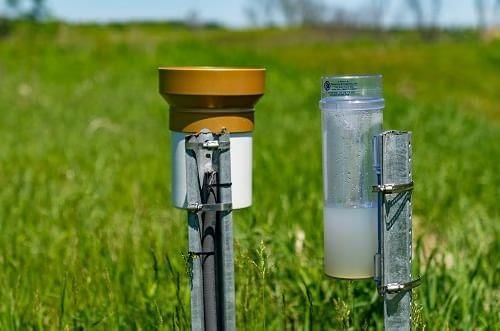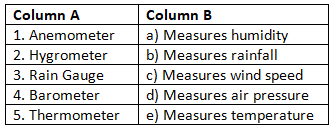CBSE Class 7 Social Science Chapter 2 Understanding the Weather Worksheet - Free Download
| Table of contents |

|
| Multiple Choice Questions (MCQs) |

|
| Fill in the Blanks |

|
| Very Short Answer Questions |

|
| Short Answer Questions |

|
| Match the Following |

|
Multiple Choice Questions (MCQs)
Q1: Which layer of the atmosphere is responsible for weather phenomena?
a) Stratosphere
b) Thermosphere
c) Troposphere
d) Mesosphere
Q2: Which instrument is used to measure atmospheric pressure?
a) Thermometer
b) Barometer
c) Hygrometer
d) Anemometer
Q3: What is the unit of measurement for rainfall in a rain gauge?
a) Kilometers
b) Degrees
c) Millimeters
d) Millibars
 Rain GaugeQ4: Which weather condition is caused by low atmospheric pressure?
Rain GaugeQ4: Which weather condition is caused by low atmospheric pressure?
a) Snowfall
b) Depression
c) Fog
d) Lightning
Q5: Which of the following instruments is used to measure humidity?
a) Hygrometer
b) Thermometer
c) Barometer
d) Wind Vane
Q6: What is used to measure wind speed?
a) Wind Vane
b) Barometer
c) Anemometer
d) Rain Gauge
Q7: What is the normal atmospheric pressure at sea level?
a) 1000 mb
b) 650 mb
c) 1013 mb
d) 950 mb
Q8: Which state has high humidity, making clothes dry slower?
a) Delhi
b) Jaipur
c) Kochi
d) Shimla
Q9: Which of the following best describes weather?
a) Monthly climate of a region
b) Permanent atmospheric condition
c) Short-term atmospheric condition
d) Long-term rainfall pattern
Q10: Which department in India issues weather warnings?
a) IMD
b) WHO
c) NDRF
d) UNESCO
Fill in the Blanks
Q1: The __________ is the lowest layer of the atmosphere where all weather happens.
Q2: A __________ is used to measure temperature.
Q3: A rain gauge measures __________ in millimeters.
Q4: __________ is the weight of air pressing down on the Earth's surface.
Q5: The __________ measures wind direction.
Q6: The instrument used to measure wind speed is the __________.
Q7: The __________ measures humidity in the air.
Q8: __________ stations combine instruments to measure all weather elements.
Q9: The mean daily temperature is calculated by adding maximum and minimum temperatures and dividing by __________.
Q10: High humidity __________ the rate of evaporation.
Very Short Answer Questions
Q1: What is the standard atmospheric pressure at sea level?
Q2: Which tool is used to measure rainfall?
Q3: Name the instrument used to measure humidity.
Q4: In which Indian city was an AWS set up in 2023 at over 4800 meters?
Q5: What does IMD stand for?
Short Answer Questions
Q1: Why are weather predictions important?
Q2: What does an anemometer do and how does it work?
Q3: How does atmospheric pressure affect mountaineers?
Q4: What is the role of AWS in weather monitoring?
Q5: How is humidity measured and why is it important?
Match the Following
(Match Column A with the correct option in Column B)

For Worksheet Solutions, go to Worksheet Solutions: Understanding the Weather
|
1 videos|107 docs
|
FAQs on CBSE Class 7 Social Science Chapter 2 Understanding the Weather Worksheet - Free Download
| 1. What are the main factors that influence weather? |  |
| 2. How can we measure humidity? |  |
| 3. What is the difference between weather and climate? |  |
| 4. Why is it important to study weather patterns? |  |
| 5. How do meteorologists forecast the weather? |  |





















